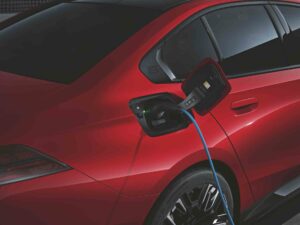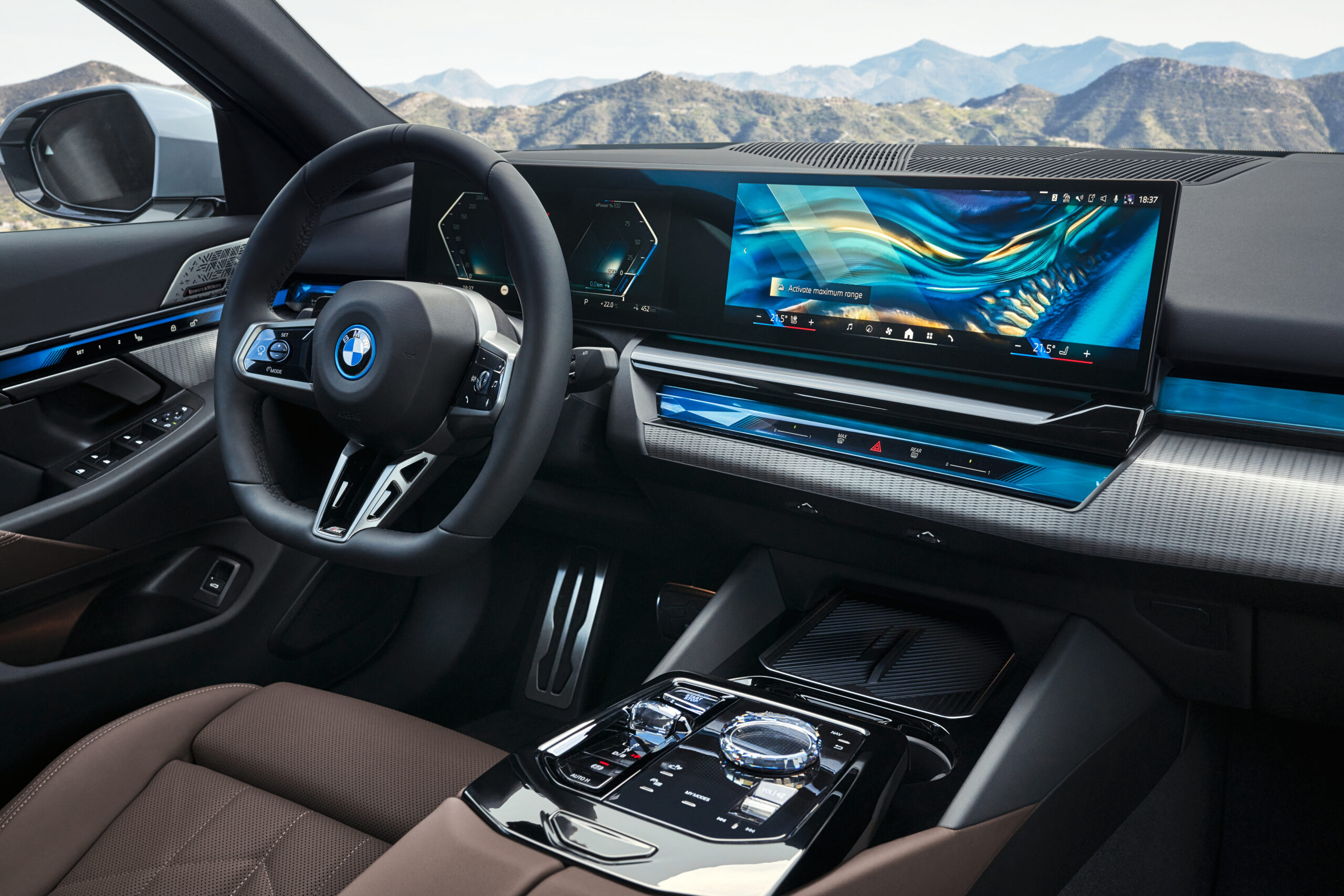
BMW to launch first all-electric 5 Series, includes eye-directed lane change
By onMarket Trends
BMW’s new 5 Series vehicles will come to market in October with a new advanced driver assistance system (ADAS) feature — lane changing by eye movement.
Active Lane Change can be used by the driver by looking in the rearview mirror. The vehicle suggests a lane change then the driver confirms it by looking in the corresponding outside rearview mirror making it no longer necessary to confirm lane changes with the turn signal.
Active Lane Change performs necessary steering movements automatically up to 85 mph with traffic conditions and speed limits permitting. This seamless interaction between the driver and the Automatic Lane Change provides a level of comfort and safety unique in the automotive sector.
Motortrend reports that it sees potential safety hazards with the new tech. “BMW describes this as a ‘comfort feature’ but we’d be lying if we weren’t slightly concerned about inadvertent confirmation (and also about the perceived benefit of the eye-based confirmation). Sure, cue up the jokes about BMW drivers not knowing where the turn signal stalk is …the reality is that it’s not an arduous process to move your hand a few inches and touch the stalk, and there’s a lot less potential for the car to misinterpret the action. We’ll have to try this system out once the car is available for review to see for ourselves.”
To be familiarized with the cabin and functionality of each vehicle’s systems, drivers can view an augmented reality representation combined with graphics and information.
The optional Driving Assistance Professional Package now includes Highway Assistant, which enables attentive hands-free driving at speeds up to 85 mph where conditions and speed limits allow. Driver attention is continuously monitored by the system with an interior camera. The driver is fully responsible for the task of driving even when the Highway Assistant is activated and must always be able to take over if necessary.
The 5 Series vehicles are also offered, for the first time, with an all-electric drivetrain. There will still be a “highly efficient” internal combustion engine (ICE) vehicle option with 48-volt mild hybrid technology. And in 2024, there will be a plug-in hybrid system in the 5 Series.
The 5 Series dates back to 1972 and by this spring, more than 10 million have been produced. The new models include the 530i, 530i xDrive, i5 eDrive40, i5 M60 xDrive, and 540i xDrive. Production of the 540i xDrive will begin in November.
BMW says its new 5 Series is “right at the center of the brand’s portfolio of four-door models — more present and elegant than the 3 Series, more dynamic and sporty than the 7 Series.”
The heightened presence of the new BMW 5 Series is underscored by the athletic proportions and the larger exterior dimensions compared to the previous generation. The new model is slightly longer and wider and has an increased wheelbase for seating comfort. All the lines of the front apron and the long hood, which connects directly to the kidney grille frame, run toward the front fascia.
The range of exterior paint colors includes one solid finish, nine metallic finishes, and three BMW Individual paint finishes — two of which are Frozen paint finishes.
Interior innovations include a curved information display behind the steering wheel, a 14.9-inch control display, interaction bar that provides ambient lighting in the instrument panel and door area (standard on i5 models, optional on 530i and 530i xDrive), My Modes for a customizable driving and interior experience, and the new gear selector switch on the center console control panel.
The control system is designed to be operated primarily by means of the touch screen and natural language but also includes steering wheel buttons and the BMW iDrive Controller on the center console. The BMW head-up display and BMW Natural Interaction primarily rely on gestures for function control. It’s available as optional equipment.
A panoramic Sky Lounge roof can be ordered in place of the standard slide-and-tilt moonroof for the first time in any BMW 5 Series sedan. It is designed as a fixed structural module, and connects almost the entire roof surface; extending uninterrupted from just behind the windscreen to almost the rear window.
The electric motor of the BMW i5 eDrive40, located at the rear axle, generates a maximum power output of 335 horsepower and maximum torque of 295 lb-ft, or 317 lb-ft when the Sport Boost or Launch Control function is activated. The BMW i5 M60 xDrive sits at the top of the 5 Series range and combines a 590 horsepower electric drivetrain with M performance characteristics and specific design features.
Like the drive units, the high-voltage battery used in each BMW i5 model is derived from the latest fifth-generation BMW eDrive technology. It is composed of four modules with 72 battery cells each and three modules with 12 cells each. The high-voltage battery has a low profile and can fit into the underbody of the BMW i5 to save space. The battery provides 84.3 kWh and when fitted with standard 19-inch wheels, is estimated to travel 295 miles on one charge.
The i5’s range can be moderated by activating a new drive system function called Max Range. The mode carefully restricts drive power and top speed and comfort functions scaled back to conserve battery power. Max Range is meant to be used in situations where the driver isn’t able to charge the vehicle.
The all-electric models in the new BMW 5 Series are the first BMWs to use Plug & Charge, which eliminates the need for account access through the provider’s app or card at compatible public charging stations.
The internal combustion engines offered in the new BMW 5 Series all stem from a common modular design. The associated innovations include the Miller combustion process, which shortens the opening times of the intake valves, a redesign of the intake ducts and combustion chambers, as well as innovations in the areas of camshaft control, injection, ignition system, and exhaust gas routing.
The engines will also feature the latest version of the fully variable valve control, Valvetronic. Their switchable rocker arms on the exhaust side make it possible to stop the gas exchange when required to reduce the engine’s frictional torque in overrun phases by about two-thirds. This allows braking energy to be recuperated more effectively.
All BMW 5 Series vehicles come standard with the latest version of electromechanical power steering (EPS) that offer a new, more direct angle-dependent steering ratio.
The new BMW 5 Series now features near-actuator wheel slip limitation to deliver maximum agility and control in demanding driving situations. With this system, the traction control is integrated into the engine control unit.
A technology suite featuring the latest generation of cameras, ultrasonic and radar sensors, a new software stack, a powerful computing platform, and a connection to the BMW Cloud via 5G mobile communications enables the” outstanding functionality of BMW’s current systems and offers unique potential for developing future automated driving functions,” BMW said.
More details about the BMW 5 Series features are available at bmwusa.com.
Images
Featured image: 2024 BMW i5 M60 xDrive (Provided by BMW)
Interior of the 2024 BMW i5 eDrive40 (Provided by BMW)
Exterior of the 2024 BMW i5 eDrive40 (Provided by BMW)


